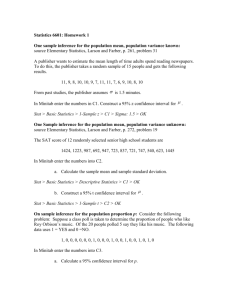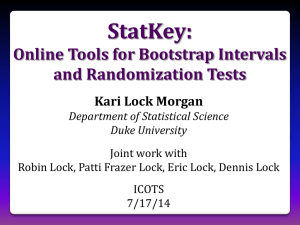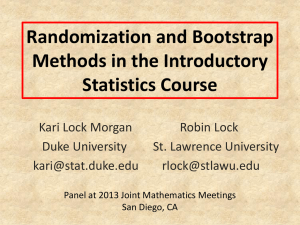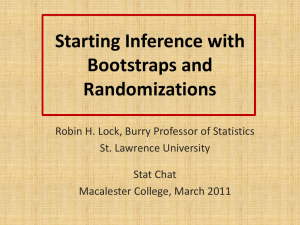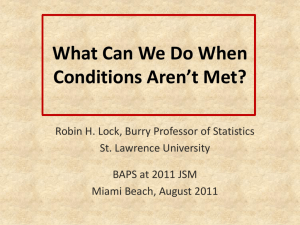Sample from this
advertisement
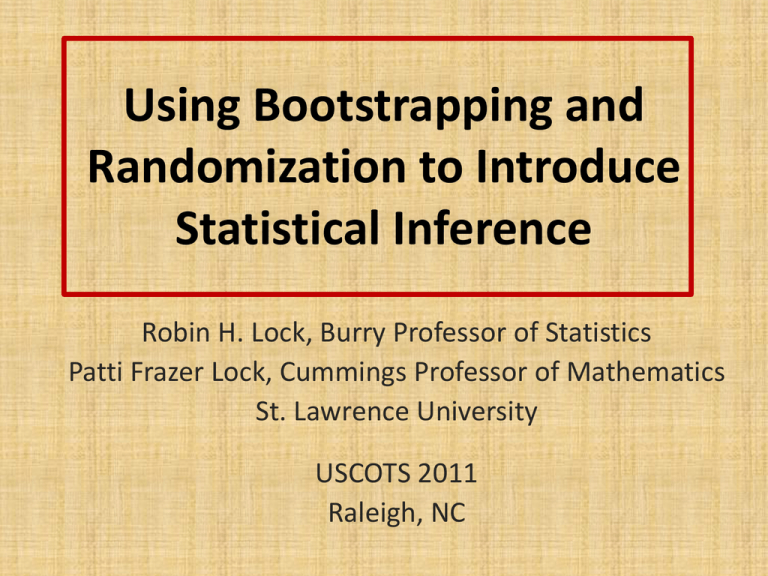
Using Bootstrapping and Randomization to Introduce Statistical Inference Robin H. Lock, Burry Professor of Statistics Patti Frazer Lock, Cummings Professor of Mathematics St. Lawrence University USCOTS 2011 Raleigh, NC The Lock5 Team Dennis Iowa State Kari Harvard/Duke Eric UNC- Chapel Hill Robin & Patti St. Lawrence Question Can you use your clicker? A. Yes B. No C. Not sure D. I don’t have a clicker Setting Intro Stat – an introductory statistics course for undergraduates “introductory” ==> no formal stat pre-requisite AP Stat counts as “undergraduate” Question Do you teach a Intro Stat? A. Very regularly (most semesters) B. Regularly (most years) C. Occasionally D. Rarely (every few years) E. Never Question Have you used randomization methods in Intro Stat? A. Yes, as a significant part of the course B. Yes, as a minor part of the course C. No D. What are randomization methods? Question Have you used randomization methods in any statistics class that you teach? A. Yes, as a significant part of the course B. Yes, as a minor part of the course C. No D. What are randomization methods? Intro Stat - Traditional Topics • Descriptive Statistics – one and two samples • Normal distributions • Data production (samples/experiments) • Sampling distributions (mean/proportion) • Confidence intervals (means/proportions) • Hypothesis tests (means/proportions) • ANOVA for several means, Inference for regression, Chi-square tests QUIZ Choose an order to teach standard inference topics: _____ Test for difference in two means _____ CI for single mean _____ CI for difference in two proportions _____ CI for single proportion _____ Test for single mean _____ Test for single proportion _____ Test for difference in two proportions _____ CI for difference in two means Intro Stat – Revise the Topics • • •• • • • • Descriptive Statistics – one and two samples Normal distributions Bootstrap confidence intervals Data production (samples/experiments) Randomization-based hypothesis tests Sampling distributions (mean/proportion) Normal/sampling distributions Confidence intervals (means/proportions) ? • Hypothesis tests (means/proportions) • ANOVA for several means, Inference for regression, Chi-square tests ? Question Data Description: Summary statistics & graphs Data Production: Sampling & experiments What is your preferred order? A. Description, then Production B. Production, then Description C. Mix them up Example: Reese’s Pieces Sample: 52/100 orange Where might the “true” p be? “Bootstrap” Samples Key idea: Sample with replacement from the original sample using the same n. Imagine the “population” is many, many copies of the original sample. Simulated Reese’s Population Sample from this “population” Creating a Bootstrap Sample: Class Activity? What proportion of Reese’s Pieces are orange? Original Sample: 52 orange out of 100 pieces How can we create a bootstrap sample? • • • • Select a candy (at random) from the original sample Record color (orange or not) Put it back, mix and select another Repeat until sample size is 100 Creating a Bootstrap Distribution 1. Compute a statistic of interest (original sample). 2. Create a new sample with replacement (same n). 3. Compute the same statistic for the new sample. 4. Repeat 2 & 3 many times, storing the results. 5. Analyze the distribution of collected statistics. Time for some technology… Bootstrap Proportion Applet Example: Atlanta Commutes What’s the mean commute time for workers in metropolitan Atlanta? Data: The American Housing Survey (AHS) collected data from Atlanta in 2004. Sample of n=500 Atlanta Commutes CommuteAtlanta Dot Plot n = 500 𝑥 =29.11 minutes s = 20.72 minutes 20 40 60 80 100 120 140 160 Time Where might the “true” μ be? 180 Creating a Bootstrap Distribution 1. Compute a statistic of interest (original sample). 2. Create a new sample with replacement (same n). 3. Compute the same statistic for the new sample. 4. Repeat 2 & 3 many times, storing the results. 5. Analyze the distribution of collected statistics. Time for some technology… Bootstrap Distribution of 1000 Atlanta Commute Means Mean of 𝑥’s=29.09 Std. dev of 𝑥’s=0.93 Using the Bootstrap Distribution to Get a Confidence Interval – Version #1 The standard deviation of the bootstrap statistics estimates the standard error of the sample statistic. Quick interval estimate : 𝑂𝑟𝑖𝑔𝑖𝑛𝑎𝑙 𝑆𝑡𝑎𝑡𝑖𝑠𝑡𝑖𝑐 ± 2 ∙ 𝑆𝐸 For the mean Atlanta commute time: 29.11 ± 2 ∙ 0.93 = 29.11 ± 1.86 = (27.25, 30.97) Using the Bootstrap Distribution to Get a Confidence Interval – Version #2 95% CI=(27.24,31.03) 27.24 Chop 2.5% in each tail 31.03 Keep 95% in middle Chop 2.5% in each tail For a 95% CI, find the 2.5%-tile and 97.5%-tile in the bootstrap distribution 90% CI for Mean Atlanta Commute 90% CI=(27.60,30.61) Chop 5% in each tail 27.60 30.61 Keep 90% in middle Chop 5% in each tail For a 90% CI, find the 5%-tile and 95%-tile in the bootstrap distribution 99% CI for Mean Atlanta Commute 99% CI=(26.73,31.65) 26.73 Chop 0.5% in each tail 31.65 Keep 99% in middle Chop 0.5% in each tail For a 99% CI, find the 0.5%-tile and 99.5%-tile in the bootstrap distribution Bootstrap Confidence Intervals Version 1 (2 SE): Great preparation for moving to traditional methods Version 2 (percentiles): Great at building understanding of confidence intervals Using the Bootstrap Distribution to Get a Confidence Interval Ex: NFL uniform “malevolence” vs. Penalty yards r = 0.430 Find a 95% CI for correlation Try web applet -0.053 0.430 0.729 Using the Bootstrap Distribution to Get a Confidence Interval – Version #3 0.483 -0.053 0.299 0.430 0.729 “Reverse” Percentile Interval: Lower: 0.430 – 0.299 = 0.131 Upper: 0.430 + 0.483 = 0.913 Question Which of these methods for constructing a CI from a bootstrap distribution should be used in Intro Stat? (choosing more than one is fine) #1: +/- multiple of SE A. Yes B. No C. Unsure #2: Percentile A. Yes B. No C. Unsure #3: Reverse percentile A. Yes B. No C. Unsure Question Which of these methods for constructing a CI from a bootstrap distribution should be used in Intro Stat? (choosing more than one is fine) #1: +/- multiple of SE #2: Percentile #3: Reverse percentile A. Yes B. No C. Unsure Question Which of these methods for constructing a CI from a bootstrap distribution should be used in Intro Stat? (choosing more than one is fine) #1: +/- multiple of SE #2: Percentile #3: Reverse percentile A. Yes B. No C. Unsure Question Which of these methods for constructing a CI from a bootstrap distribution should be used in Intro Stat? (choosing more than one is fine) #1: +/- multiple of SE #2: Percentile #3: Reverse percentile A. Yes B. No C. Unsure What About Hypothesis Tests? “Randomization” Samples Key idea: Generate samples that are (a) consistent with the null hypothesis AND (b) based on the sample data. Example: Cocaine Treatment Conditions (assigned at random): Group A: Desipramine Group B: Lithium Response: (binary categorical) Relapse/No relapse Treating Cocaine Addiction Randomly to Desipramine or Lithium Start Record with theassign 48data: subjects Relapse/No Relapse Group A: Desipramine Group B: Lithium Cocaine Treatment Results Relapse No Relapse Desipramine 10 14 24 Lithium 18 6 24 28 20 Is this difference “statistically significant”? Key idea: Generate samples that are (a) consistent with the null hypothesis (b) based on the sample data. Relapse No Relapse Desipramine 10 14 24 Lithium 18 6 24 28 20 H0 : Drug doesn’t matter Key idea: Generate samples that are (a) consistent with the null hypothesis (b) based on the sample data. In 48 addicts, there are 28 relapsers and 20 no-relapsers. Randomly split them into two groups. How unlikely is it to have as many as 14 of the no-relapsers in the Desipramine group? Cocaine Treatment- Simulation 1. Start with a pack of 48 cards (the addicts). 28 Relapse: Cards 3 – 9 20 Don’t relapse: Cards 10,J,Q,K,A 2. Shuffle the cards and deal 24 at random to form the Desipramine group (Group A). 3. Count the number of “No Relapse” cards in simulated Desipramine group. Automate this 4. Repeat many times to see how often a random assignment gives a count as large as the experimental count (14) to Group A. Distribution for 1000 Simulations Number of “No Relapse” in Desipramine group under random assignments 28/1000 Understanding a p-value The p-value is the probability of seeing results as extreme as the sample results, if the null hypothesis is true. Example: Mean Body Temperature Is the average body temperature really 98.6oF? H0:μ=98.6 Ha:μ≠98.6 Data: A random sample of n=50 body temperatures. Dot Plot BodyTemp50 n = 50 𝑥 =98.26 s = 0.765 96 97 98 99 BodyTemp 100 Data from Allen Shoemaker, 1996 JSE data set article 101 Key idea: Generate samples that are (a) consistent with the null hypothesis (b) based on the sample data. H0: μ=98.6 How to simulate samples of body temperatures to be consistent with H0: μ=98.6? Sample: n = 50, 𝑥 =98.26, s = 0.765 Randomization Samples How to simulate samples of body temperatures to be consistent with H0: μ=98.6? 1. Add 0.34 to each temperature in the sample (to get the mean up to 98.6). 2. Sample (with replacement) from the new data. 3. Find the mean for each sample (H0 is true). 4. See how many of the sample means are as extreme as the observed 𝑥 =98.26. Randomization Distribution Measures from Sample of BodyTemp50 Dot Plot 𝑥 =98.26 98.2 98.3 98.4 98.5 98.6 xbar 98.7 98.8 Looks pretty unusual… p-value ≈ 1/1000 x 2 = 0.002 98.9 99.0 Connecting CI’s and Tests Measures from Sample of BodyTemp50 Dot Plot Randomization body temp means when μ=98.6 98.2 98.3 98.4 98.5 Measures from Sample of BodyTemp50 98.6 xbar 98.7 98.8 98.9 99.0 Dot Plot Bootstrap body temp means from the original sample 97.9 98.0 98.1 98.2 98.3 98.4 bootxbar 98.5 98.6 98.7 Fathom Demo Fathom Demo: Test & CI Choosing a Randomization Method Example: Finger tap rates (Handbook of Small Datasets) A=Caffeine 246 248 250 252 248 250 246 248 245 250 mean=248.3 B=No Caffeine 242 245 244 248 247 248 242 244 246 241 mean=244.7 H0: μA=μB vs. Ha: μA>μB Reallocate Option 1: Randomly scramble the A and B labels and assign to the 20 tap rates. Resample Option 2: Combine the 20 values, then sample (with replacement) 10 values for Group A and 10 values for Group B. “Randomization” Samples Key idea: Generate samples that are (a) consistent with the null hypothesis AND (b) based on the sample data and (c) Reflect the way the data were collected. “Reallocation” vs. “Resampling” Question In Intro Stat, how critical is it for the method of randomization to reflect the way data were collected? A. Essential B. Relatively important C. Desirable, but not imperative D. Minimal importance E. Ignore the issue completely What about Traditional Methods? Transitioning to Traditional Inference AFTER students have seen lots of bootstrap distributions and randomization distributions… Students should be able to • Find, interpret, and understand a confidence interval • Find, interpret, and understand a p-value Transitioning to Traditional Inference • Introduce the normal distribution (and later t) • Introduce “shortcuts” for estimating SE for proportions, means, differences, slope… Confidence Interval: 𝑆𝑎𝑚𝑝𝑙𝑒 𝑆𝑡𝑎𝑡𝑖𝑠𝑡𝑖𝑐 ± 𝑧 ∗ ∙ 𝑆𝐸 Hypothesis Test: 𝑆𝑎𝑚𝑝𝑙𝑒 𝑆𝑡𝑎𝑡𝑖𝑠𝑡𝑖𝑐 − 𝑁𝑢𝑙𝑙 𝑃𝑎𝑟𝑎𝑚𝑒𝑡𝑒𝑟 𝑆𝐸 Toyota Prius – Hybrid Technology Question Order of topics? A. Randomization, then traditional B. Traditional, then randomization C. No (or minimal) traditional D. No (or minimal) randomization QUIZ Choose an order to teach standard inference topics: _____ Test for difference in two means _____ CI for single mean _____ CI for difference in two proportions _____ CI for single proportion _____ Test for single mean _____ Test for single proportion _____ Test for difference in two proportions _____ CI for difference in two means What about Technology? Possible Technology Options • • • • • • • • • • Fathom/Tinkerplots R Minitab (macro) SAS Matlab Try some out at a breakout Excel session tomorrow! JMP StatCrunch Web apps Others? What about Assessment? An Actual Assessment Final exam: Find a 98% confidence interval using a bootstrap distribution for the mean amount of study time during final exams Study Hours Dot Plot 10 20 30 40 50 60 Hours Results: 26/26 had a reasonable bootstrap distribution 24/26 had an appropriate interval 23/26 had a correct interpretation Support Materials? We’re working on them… Interested in learning more or class testing? rlock@stlawu.edu plock@stlawu.edu www.lock5stat.com Example: CI for Weight Gain Does binge eating for four weeks affect long-term weight and body fat? 18 healthy and normal weight people with an average age of 26. Construct a confidence interval for mean weight gain 2.5 years after the experiment, based on the data for the 18 participants. Construct a bootstrap confidence interval for mean weight gain two years after binging, based on the data for the 18 participants. a). Parameter? Population? b). Suppose that we write the 18 weight gains on 18 slips of paper. Use these to construct one bootstrap sample. c). What statistic is recorded? d). Expected shape and center for the bootstrap distribution? e). Use a bootstrap distribution to find a 95% CI for the mean weight gain in this situation. Interpret it. Example: Sleep vs. Caffeine for Memory Is a nap or a caffeine pill better at helping people memorize a list of words? 24 adults divided equally between two groups and given a list of 24 words to memorize. Sleep 14 18 11 13 18 17 21 9 Caffeine 12 12 14 13 6 14 16 10 7 18 16 17 14 15 15 10 Mean=15.25 Mean=12.25 Test to see if there is a difference in the mean number of words participants are able to recall depending on whether the person sleeps or ingests caffeine. Test to see if there is a difference in the mean number of words participants are able to recall depending on whether the person sleeps or ingests caffeine. a). Hypotheses? b). What assumption do we make in creating the randomization distribution? c). Describe how to use 24 cards to physically find one point on the randomization distribution. How is the assumption from part (b) used in deciding what to do with the cards? d). Given a randomization distribution: What does one dot represent? e). Given a randomization distribution: Estimate the p-value for the observed difference in means. e). At a significance level of 0.01, what is the conclusion of the test? Interpret the results in context. Example: Finger tap rates A=Caffeine 246 248 250 252 248 250 246 248 245 250 mean=248.3 B=No Caffeine 242 245 244 248 247 248 242 244 246 241 mean=244.7 If we test: H0: μA=μB vs. Ha: μA>μB,which of the following methods for generating randomization samples is NOT consistent with H0. Explain why not. A: Randomly scramble the A and B labels and assign to the 20 tap rates. B: Sample (with replacement) 10 values from Group A and 10 values from Group B. C: Combine the 20 values, then sample (with replacement) 10 values for Group A and 10 values for Group B. D: Add 1.8 to each B rate and subtract 1.8 from each A rate (to make both means equal to 246.5). Sample 10 values (with replacement) within each group.

